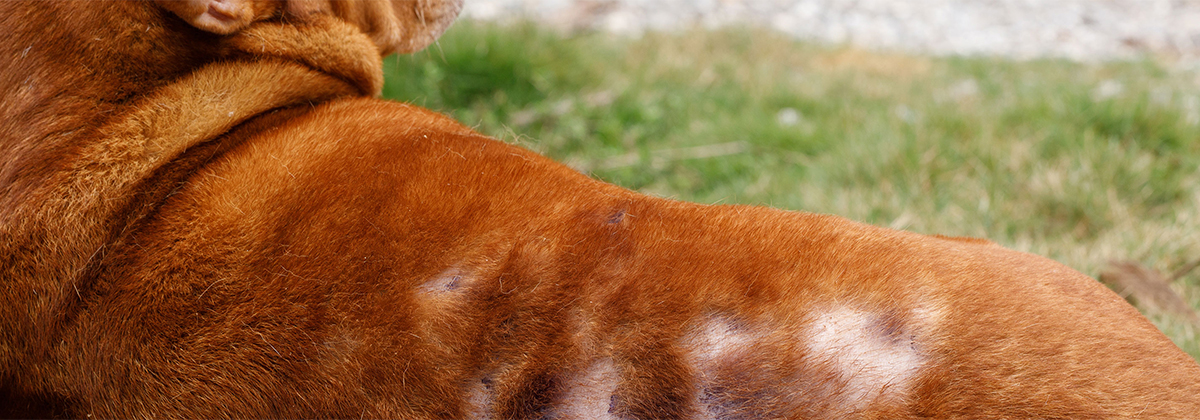11 Mar Mange in Dogs: Causes, Symptoms, & Treatment
Your dog is always licking and scratching himself, and his coat is flaking and losing hair. Mange in dogs is a skin disease caused by tiny mites, foreign parasites and other causes. Some mange may be present naturally in your dog’s skin and hair follicles. All mites, when propagated, cause mild to severe skin infections.
Mange in dogs factors:
The most important causes are lack of hygiene, proximity to sick dogs or contaminated places such as nests, animal shelters, dog parks, groomers and veterinary clinics. Sarcoptic mange is easily and quickly transmitted between dogs. Oval, light-coloured, microscopic mites cause itching. All dogs raised by their mothers congenitally have demodectic mites transmitted to the puppy through the mother during the first few days.
Most dogs can always live with their mites and never have a problem. Demodectic mites can be transmitted from one dog to another; But as long as the dogs are healthy, the mites won’t cause any skin disease. Dogs should be separated only if the disease is contagious. The mites and the disease can also be transmitted to humans or cats but aren’t severe. Humans who contract mange dogs may have red rashes on their arms, chest or abdomen. There are three types of demodicosis that affect dogs.
- Localized mange occurs when mites multiply in one or two small, confined areas, resulting in scaly patches and spots on the dog’s face. Localized demodicosis is a common disease in puppies, and almost 90% of cases go away without any treatment.
- In contrast to topical mange, generalized demodectic mange affects larger areas of the dog’s skin or the entire body. Secondary bacterial infections in the disease cause severe itching and smelly diseases in dogs. Itching can also sign a defective immune system, an inherited problem, an endocrine problem or other basic health problems. Treatment depends on the age at which the dog becomes infected.
- One of the most difficult types of mange is demotic foot pododermatitis, which causes bacterial infections. An in-depth biopsy usually needs to be done to pinpoint the mites location and make the correct diagnosis.
Mange in dogs symptoms:
Mange has different symptoms and varies depending on the type of mites in dogs.
- Demodectic mange develops on dogs’ skin and hair follicles, causing hair loss, bald spots, scaling and scarring. It occurs when the dog’s skin becomes highly contaminated, and the immune system is strained, or your dog’s defence system is too weak to fight off the infection. This problem causes the skin at the root of the follicle to become inflamed, itchy and hair loss. Secondary bacterial infections can make the disease itchy and uncomfortable; Fortunately, this disease isn’t contagious.
- Sarcoptic mange develops deep in the skin and causes severe itching, hair loss, skin redness, body wounds, scaling and restlessness. These symptoms usually appear one week after the illness. The dog’s most affected body areas include the ears, elbows, face and legs, but as the disease progresses, it may spread rapidly throughout the body.
Mange in dogs treatments:
Take your dog to a veterinarian for a physical examination and several tests, such as a blood and urine test. He also analyzes the skin scratches and confirms mites’ presence on your dog’s skin with a microscope. Identifying mites deep in a dog’s skin is difficult, so your veterinarian may review your dog’s clinical signs or history for a definitive diagnosis. Certain dogs are more prone to scabies. These dogs are:
- Puppies and dogs under 18 months are prone to localized mange, which often resolves on its own.
- Generalized demodectic mange is a more serious and pervasive type that can be inherited in dogs.
- Old English sheepdogs, shar peis and older dogs have an underlying disease, prone to severe demotic dermatitis that affects the legs.
The first step in treatment is to isolate the dog from other pets to prevent the disease’s spread. Your veterinarian may prescribe anti-parasitic, anti-itch, anti-inflammatory and anti-inflammatory drugs for secondary skin infections. Treatment for mange varies depending on the mites type and your dog breed, and the medication may be given orally, topically, by injection, or through shampoo. The treatment results are visible after a month.
Young dogs usually recover quickly, but treatment for adult dogs is often long and about 6 weeks. The vet should scratch the skin every two weeks at the same time as the treatment. After two consecutive scratches are negative, the drug can be discontinued. But the final should be scratched one month after complete treatment to make sure the disease doesn’t recur.
Prevent mange recurrence :
Thoroughly clean and change your dog’s bedding and collar. Examine all animals in contact with the sick dog and treat if infected. Don’t forget that you should wear gloves when handling your dog during the treatment, and then be sure to wash your hands thoroughly with soap and water. You should also wash her bedding and any clothes or surfaces your dog has come in contact with, including bedding, clothing, furniture, curtains and rugs. If your neighbour’s dog is infected, keep your pets indoors to keep them away from the disease. Take your dog to the vet periodically to make sure the mites are eradicated.
Mishka’s professional team specializes in solving pet behavioural problems. Note that only authorized veterinarians can diagnose your dog’s medical condition; But we also provide the information needed for proper nutrition, good care, accurate identification and understanding of the disease. Ignoring treatment can make your dog worse and put his life at risk.




No Comments